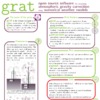Rajner M. „grat — open source software for computing atmospheric gravity correction using numerical weather models”. iag Scientific Assembly (iag 150 years). Poczdam, Niemcy.
- [bib]
@conference{Rajner2013_iag,
}date = {2013-09-01}, month = {sep}, year = {2013}, author = {Rajner, Marcin}, title = {grat — open source software for computing atmospheric gravity correction using numerical weather models}, eventtitle = {iag Scientific Assembly}, eventtitleaddon = {iag 150 years}, eventdate = {2013-09-01/2013-09-06}, venue = {Dorint Hotel}, address = {Poczdam, Niemcy}, note = {poster wyróżniony}, - [streszczenie]
In order to fully utilize the accuracy of modern ballistic and superconducting gravimeters we have to be able to remove all sources of disturbances in the measurements. One of the main effect is impact of atmosphere masses on surface gravity values. Usually we take this into account using pressure measurements along with single admittance factor. If the continuous gravity measurements at the site are at our disposal we can determine this factor by means of statistical methods. These methods perform very well and major part of atmospheric disturbances can be removed. Nevertheless these methods do not reflect the physical phenomena and are not adequate when accuracy of a few microGal is needed. This can be extremely important when one uses gravity measurements for tectonic studies. In this paper I introduce a new computer program (called grat) to facilitate computation of atmospheric gravity correction making extensive use of numerical weather models. Using meteorological parameters we can perform computation using 2D method (surface pressure with exponential pressure changes with height) and 3D method (numerical integration for vertical layers). We can compute separate the deformation as well as attraction terms using different Earth models and numerical weather models. We can also add the temperature, topography and Inverted Barometer effect. All possible combinations make this flexible and versatile tool. In opposition to existing services (atmacs and loading.u-strasbg.fr) we are not restricted for specific sites and we can perform computation according to our needs with use of plethora of switches. All sources of program (fully written in Fortran90 with elements of Fortran2003) are freely available. The usefulness of this program will be presented with comparison to other methods and services and with comparison with real data from absolute and relative gravimeters.
- [.pdf]
- [url]
